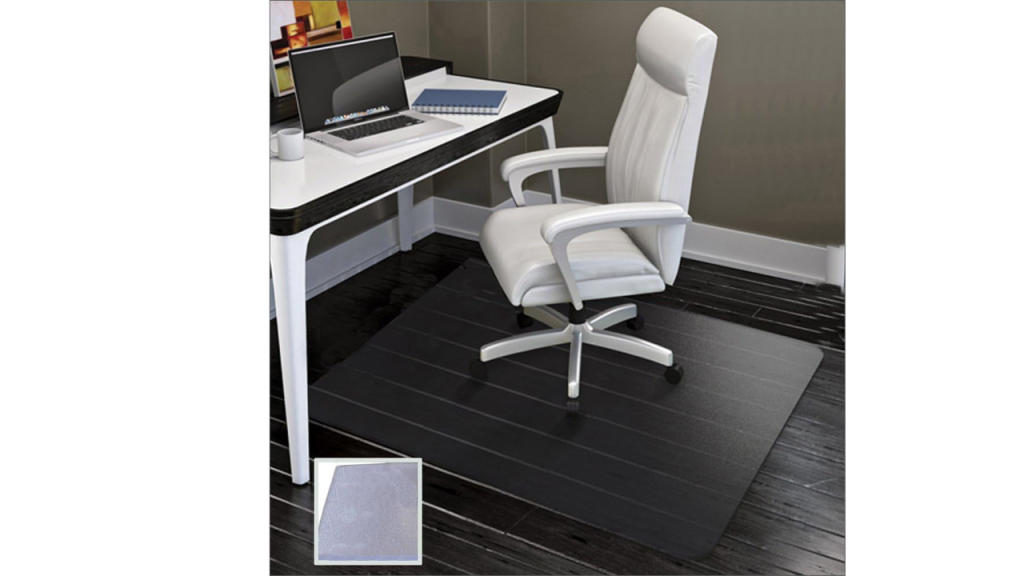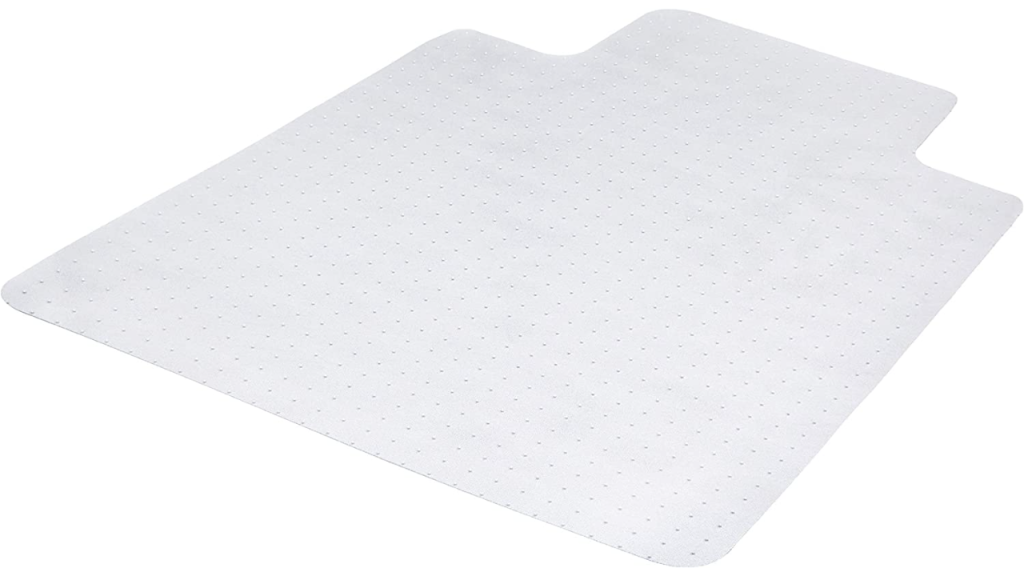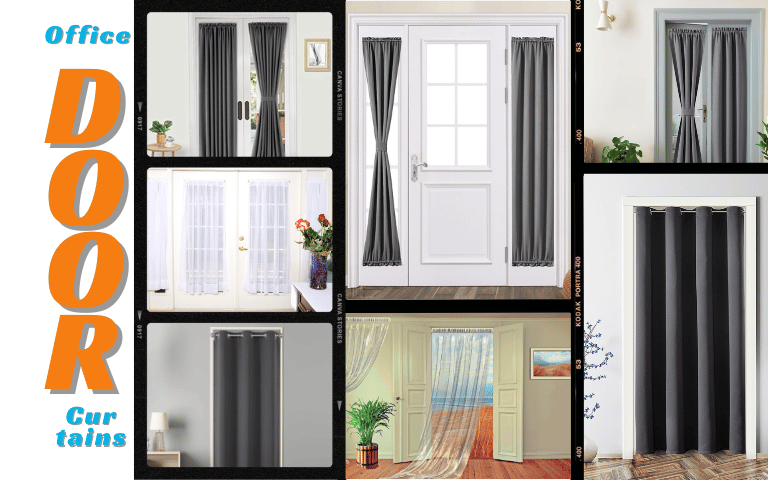Chair mats play a vital role in safeguarding our floors from the wear and tear caused by the daily use of office chairs. They provide an essential barrier between the chair’s casters and the flooring surface, preventing scratches, scuffs, and dents. Not only do chair mats enhance the longevity of our floors, but they also contribute to a professional and well-maintained workspace. Let’s begin with PVC vs Polycarbonate chair mat comparison for better understanding.
In the realm of chair mats, two popular materials stand out: PVC and polycarbonate. PVC is a versatile synthetic plastic known for its durability and affordability, making it a common choice for chair mats. On the other hand, polycarbonate is a transparent, high-performance thermoplastic known for its exceptional strength and impact resistance. These two materials offer distinct features and benefits, prompting a closer examination of their floor protection capabilities.
This blog post aims to conduct a comprehensive comparison between pvc vs polycarbonate chair mat to determine which material provides better floor protection. Join us as we explore the battle of PVC versus polycarbonate, and uncover which material reigns supreme in the realm of floor protection.
Understanding PVC Chair Mats
PVC (Polyvinyl Chloride) is a synthetic plastic material widely used to produce chair mats. It is known for its versatility and affordability. The material’s flexibility allows it to be molded into the desired shape while retaining its strength. PVC chair mats offer several advantages when it comes to floor protection.

Firstly, they are highly durable and resistant to wear and tear. The sturdy construction ensures that the chair mat can withstand the daily movement of chairs and the pressure exerted by the casters without showing signs of damage.
Secondly, PVC chair mats provide excellent protection against spills and stains. The waterproof material prevents liquids from seeping through and damaging the underlying floor.
Additionally, PVC chair mats are compatible with various types of flooring, including carpet, hardwood, tile, and laminate. This versatility allows users to use PVC chair mats in different areas of their workspace without worrying about compatibility issues.
Despite their benefits, PVC chair mats do have some potential drawbacks. One concern is the off-gassing of volatile organic compounds (VOCs) that may occur with certain PVC products. These emissions can contribute to indoor air pollution and may have health implications. It is essential to choose PVC chair mats that are certified as low VOC or have undergone proper off-gassing procedures to minimize this risk.
Another drawback is the susceptibility of PVC to cracking or deformation over time, particularly under heavy loads or if exposed to extreme temperatures. It is important to handle and use PVC chair mats with care to prevent such issues and ensure their longevity.
Exploring Polycarbonate Chair Mats
Polycarbonate chair mats are made from a transparent, high-performance thermoplastic known as polycarbonate. This material is renowned for its exceptional strength and impact resistance. It possesses excellent clarity and allows the natural beauty of the underlying floor to shine through. Polycarbonate chair mats offer several benefits when it comes to floor protection.
Firstly, they boast exceptional strength and impact resistance. They can withstand heavy loads, including the weight of chairs and the pressure exerted by casters, without cracking or breaking.
Secondly, polycarbonate chair mats provide enhanced clarity, allowing the aesthetic appeal of the floor. The transparency ensures that the design and texture of the flooring remain visible.
Additionally, polycarbonate chair mats are non-toxic and environmentally friendly. They are free from harmful chemicals such as phthalates and are considered safe for both humans and the environment.
However, there are a couple of potential limitations associated with polycarbonate chair mats.
One drawback is their higher price point compared to PVC chair mats. The superior properties and durability of polycarbonate contribute to its higher cost.
Another limitation is that polycarbonate chair mats may have limited compatibility with certain flooring types. While they are generally suitable for hard floors, such as hardwood and tile, they may not provide sufficient grip on certain carpeted surfaces.


Head-to-Head PVC vs Polycarbonate chair mat Comparison
When comparing the floor protection capabilities of PVC and polycarbonate chair mats, several factors come into play.
Firstly, in terms of scratch resistance, both materials offer considerable protection. PVC chair mats demonstrate good scratch resistance, effectively preventing damage caused by chair movement. However, polycarbonate chair mats excel in this aspect, as they are highly resistant to scratches and maintain their clarity even after prolonged use.
Secondly, chair movement and casters’ impact play a crucial role in floor protection. PVC chair mats generally provide satisfactory protection against chair movement and the impact of casters. While polycarbonate chair mats offer exceptional strength and impact resistance. These are highly suitable for heavy-duty use and provide superior floor protection against the constant movement and pressure exerted by chairs.
Lastly, in terms of stain and spill resistance, both pvc vs polycarbonate chair mat offer effective protection by preventing spills from seeping through and damaging the underlying floor.
When evaluating the durability and longevity of PVC and polycarbonate chair mats, both materials have their advantages. PVC chair mats are known for their durability, with the ability to withstand daily wear and tear. Polycarbonate chair mats, on the other hand, are highly durable and exhibit exceptional resistance to cracking, maintaining their structural integrity over extended periods.
In terms of maintenance and cleaning, PVC and polycarbonate chair mats offer convenience. PVC chair mats are relatively easy to clean, typically requiring a simple wipe-down with a damp cloth or mild cleaning solution. Polycarbonate chair mats also offer ease of maintenance, as they are resistant to stains and spills, requiring minimal effort to keep them clean and clear.
Overall, while both PVC and polycarbonate chair mats provide effective floor protection, polycarbonate stands out in terms of scratch resistance, impact resistance, and long-term durability. However, PVC chair mats offer satisfactory protection at a more affordable price point.
Considerations for Choosing the Right Chair Mat
When choosing the right chair mat for floor protection, several factors should be taken into consideration.
Firstly, consider the type of flooring in your workspace. Different chair mats are designed to be compatible with specific flooring types, such as carpet, hardwood, tile, or laminate. You have to ensure that the chair mat you choose is suitable for your particular flooring.
Secondly, if you have heavy chair usage or frequently move around, opt for a chair mat with superior durability and impact resistance, such as polycarbonate. For lighter usage, PVC chair mats may be more suitable.
Thirdly, budget considerations are also important. PVC chair mats are generally more affordable than polycarbonate mats, so if budget is a primary concern, PVC might be the better option.
Additionally, if you prioritize eco-friendliness, look for chair mats made from recycled or environmentally friendly materials, or those that are certified as low VOC to minimize off-gassing.
Our Recommendations
- For high-pile carpets, consider a chair mat such as a PVC chair mat with a gripper backing to prevent it from slipping or moving.
- If you have a home office with hardwood floors, choose a chair mat such as a Polycarbonate chair mat for hardwood surfaces to protect against scratches and dents.
- In heavy-traffic areas or offices with frequent chair movement, opt for a durable chair mat, such as polycarbonate, to withstand the increased wear and tear.
- If you have a limited budget but still need adequate floor protection, PVC chair mats offer a cost-effective solution.
- For those concerned about environmental impact, seek out chair mats made from recycled materials or those with environmental certifications.
In conclusion, we have thoroughly examined the comparison between PVC and polycarbonate chair mats in terms of floor protection. Recapping our findings, PVC chair mats offer excellent durability and resistance to spills and stains. However, they may be susceptible to cracking or deformation over time. On the other hand, polycarbonate chair mats excel in strength and impact resistance, while maintaining a clear and aesthetically pleasing appearance.
As for the verdict, it ultimately depends on your specific needs and preferences. If you prioritize affordability and compatibility with various flooring types, PVC may be a suitable choice. Conversely, if you seek unparalleled strength and long-term performance, polycarbonate emerges as the winner.







